MANAUS, (Reuters) – A team of biologists, vets and fishermen captured rare freshwater dolphins this week on a lake in the Amazon to study their health in the hopes of avoiding hundreds of deaths of the mammals due to a severe drought last year.
The dolphins were brought ashore for blood tests and other exams and returned to Lake Tefé as soon as the researchers had finished their work that included inserting a microchip to follow their behavior via satellite.
Fishermen were careful not to hurt an adult female dolphin during capture and kept her close to her offspring.
“She relaxed and we could do the tests. She appeared in good health,” Marmontel said. The work included removing a sample for a biopsy and the placing of the microchip on her back, which will allow researchers to follow her movements, the depths she swims at and even know the water temperatures remotely.
In a grim fallout from the longest drought in the rainforest’s recorded history last year, the carcasses of more than 200 river dolphins were found floating on the lake formed by a tributary of the Amazon River.
Low river levels during the drought heated the water to temperatures that were intolerable for the dolphins, researchers say. Thousands of fish also died on Amazon rivers due to a lack of oxygen in the water.
The Amazon river dolphins, many of a striking pink color, are a unique freshwater species found only in the rivers of South America and are one of a handful of freshwater dolphin species left in the world. Slow reproductive cycles make their populations especially vulnerable to threats.
“We study the health of the dolphins before the dry season sets in, so we can understand how they react to the heat,” said project head Miriam Marmontel, of the Mamirauá Institute of Sustainable Development that mounted the expedition planning to capture up to 20 dolphins.
She said 300 dolphins died last year, most of them in Lake Tefé, a 45-kms-wide (27 mile) expanse of water where the dolphins like to be located, just off the Solimoes River.
The lake’s water reached 40.9 degrees Celsius (105.62 Fahrenheit) during the 2023 drought, more than 10 degrees higher than the average for that time of the year. The water is currently at 30 degrees Celsius (86 degrees Fahrenheit), said Ayan Fleischmann, a geosciences researcher at the Mamirauá Institute.
Environmental activists have blamed the unusual conditions on climate change, which makes droughts and heat waves more likely and severe. Global warming’s role in last year’s Amazon drought is unclear, with other factors such as El Niño at play.





